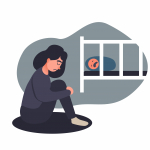Suicidal ideation is relatively common among pregnant women; however, the risk of attempted or completed suicide in this poplaiton is lower that observed in the general population. In screening women for suicidal ideation, our primary goal is to reduce the risk of suicide. The vast majority of women who report suicidal ideation will not go on to attempt or commit suicide; yet, that single question can help us to identify women with other mental health issues.
In a recent study of more than 700 low-income pregnant women in Central Illinois, researchers found that nearly 1 in 20 women (4.6%) in the study reported having suicidal thoughts (as identified using the EPDS), which is about twice as high as observed in the general population. Women with depression were 13 times as likely to report suicidal ideation; however, about one-third of the women who reported having suicidal thoughts did not report clinically significant depressive symptoms.
Other studies indicate that intimate partner violence (IPV) may be an independent risk factor for suicidal ideation during pregnancy. Another study of 168 low-income pregnant women attending an obstetrical clinic in Baltimore, the prevalence of suicidal ideation was higher, nearly 23 %. Suicidal ideation was more commonly reported in women with depressive symptomatology (odds ratio, OR=17.04) and in women experiencing IPV (OR=9.37). The authors speculate that the high prevalence of antenatal suicidal ideation may be attributable to the fact that this sample was predominantly single, low-income, and 19% of the women had experienced IPV during pregnancy.
In another study from China (Zhang et al, 2020), women at 28 weeks or more were screened using item 9 of the Patient Health Questionnaire-9. Childhood abuse was measured using childhood abuse subscales of the Childhood Trauma Questionnaire. Women with any experience of childhood abuse had high risk of suicide ideation (OR = 2.44). After adjusting for depression, pregnant women with only histories of childhood physical abuse had an increased risk of suicidal ideation (OR = 3.63). Pregnant women with both childhood abuse and depression were nearly 20 times more likely to report suicidal ideation than women without a history.
Looking at these studies together, we can conclude that suicidal ideation is relatively common and may be particularly common in certain populations with greater exposure to violence. While suicidal ideation may be a symptom of depression, it is also more common among women with trauma histories — either childhood abuse or current exposure to intimate partner violence. At the present time, we do not routinely screen pregnant women for history of trauma.
What is much harder to do is to pinpoint what are the factors that turn suicidal thoughts into suicidal behaviors. We do have some data from psychiatric hospitalization records which indicate that certain groups are at higher risk for attempting suicide during pregnancy — for example, women with histories of psychiatric hospitalization prior to pregnancy, women with substance abuse, and teen mothers. It is essential that we provide additional support to non-psychiatric health care providers, including obstetricians and pediatricians, in order to guarantee the early identification and treatment of women with perinatal mood disorders.
Ruta Nonacs, MD PhD
Zhang X, et al. Suicide ideation among pregnant women: The role of different experiences of childhood abuse. J Affect Disorder, April 2020.








Leave A Comment